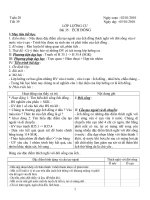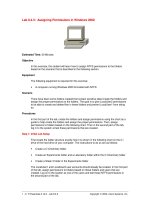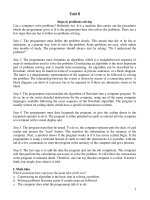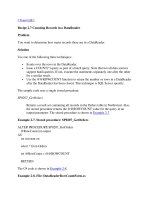Tài liệu Unit_8: Steps in problems solving ppt
Bạn đang xem bản rút gọn của tài liệu. Xem và tải ngay bản đầy đủ của tài liệu tại đây (42.78 KB, 3 trang )
1
Unit 8
Steps in problems solving
Can a computer solve problems? Definitely not. It is a machine that carries out the procedures
which the programmer gives it. It is the programmer then who solves the problems. There are a
few steps that one has to follow in problems solving.
Step 1. The programmer must define the problem clearly. This means that she or he has to
determine, in a general way, how to solve the problem. Some problems are easy, while others
take months of study. The programmer should always start by asking: “Do I understand the
problem?”
Step 2. The programmer must formulate an algorithm, which is a straightforward sequence of
steps of instructions used to solve the problem. Constructing an algorithm is the most important
part of problem solving and is usually time-consuming. An algorithm can be described by a
flowchart, which may be stated in terms of a sequence of precise sentences, or a block diagram.
The latter is a diagrammatic representation of the sequence of events to be followed in solving
the problem. The relationship between the events is shown by means of a connecting arrow. A
block diagram can show if a process has to be repeated or if there are alternative routes to be
taken.
Step 3. The programmer must translate the algorithm of flowchart into a computer program. To
do so, he or she writes detailed instructions for the computer, using one of the many computer
languages available following the exact sequence of the flowchart algorithm. The program is
usually written on coding sheets which have a specific format drawn on them.
Step 4. The programmer must then keypunch the program, or give the coding sheets to the
keypunch operator to do it. The program is either punched on cards or entered into the computer
at a terminal with a visual display unit.
Step 5. The program must then be tested. To do so, the computer operator puts the deck of card
reader and presses the “read” button. This transfers the information to the memory of the
computer. Next, a printout shows if the program works or if it has errors (called bugs). If the
programmer is using a terminal instead of cards to enter the instructions it is possible, with the
aid of a few commands, to store the program in the memory of the computer and get a printout.
Step 6. The last step is to add the data the program and run the job completely. The computer
will then perform the calculations necessary to solve the problem. It will follow the instructions
in the program to minutest detail. Therefore, one can say that the computer is a robot. It doesn’t
think, but simply does what it is told.
I. Main idea
Which statement best expresses the main idea of the text?
a. Constructing an algorithm is the basic step in solving a problem.
b. Solving problems becomes easier if certain steps are followed.
c. The computer does what the programmer tells it to do.
2
II. Understanding the passage
Are the following statements true or false?
1. The computer is a great help to people because it solves their problems.
2. All problems are equally difficult to solve.
3. An algorithm is a sequence of instructions used to solve a problem.
4. The most important part of problem solving is defining the problem clearly.
5. Block diagrams cannot show relationships.
6. Coding sheets are used for writing programs.
7. Punched cards are the only way of transferring the program to the computer memory.
8. If the data is not added to the program, the computer cannot perform calculations.
9. It is a good idea to test the program before adding the data.
10. A computer is very intelligent. It is capable of thinking.
III. Locating information
Find the place where the following ideas are expressed.
1. Programs are usually written on certain lined forms.
2. A block diagram can show a decision with two different outcomes
3. The programmer is the one who solves the problems.
4. Even if the programmer is using a terminal instead of cards, it is possible to get a permanent
copy of his program.
5. Not all problems are of the same level of difficulty
IV. Contextual reference
What do the words in bold typeface refer to?
1. It is a machine
2. which the programmer gives it
3. who solves the problems
4. which may be stated
5. the latter is a diagrammatic representation
6. operator to do it
7. This transfers the information
8. or if
it has errors
9. It will follow the instructions
10. does what it is told
V. Understanding words
Find the synonyms for the following words
1. construct
2. takes a lot of time
3. exact
4. mistakes
5. help
Find the antonyms for the following words
1. ambiguously
2. specific
3. partially
VI. Word form
Choose the appropriate form of the words to complete the sentences
1. procedure, proceed, proceeding
a. The machine carries out the ……… which the programmer gives it.
b. You should……… with care when using a calculator
2. program, programmer, programmed, programming
a. I would like to……… in COBOL
b. There were quite a few errors in my………
c. My calculator is………. It plays a tune on the hour.
d. Fortran is one of the many……… languages available on the market
e. Computer ……… is a new field of study at the university
f. He is a good……… because he always constructs algorithms for his problems.
3. relationship, relate, related
a. The first two steps in your programs are not………. They are basically different.
b. In the flowchart, the……… between events is shown by means of connecting arrows
4. code, coding
a. Do you have any……… sheets left?
b. I have to……… my program
c. Assemble is one example of a machine………
5. printer, printing, print, printed
a. ……… your name and address in block letters
b. ……… was introduced by Gutenberg in Germany in the 1400s.
c. The quality of the……… output from a daisy wheel printer is superior to that from a dot
matrix.
d. ……… provide a hard copy of the results of data processing operations
VII. Content review
Complete the following statements with the appropriate words
algorithm coding sheets flowchart
robot printout bugs
1. Special forms which are usually used for writing programs are called……..
2.
Another word for program errors is……..
3.
A number of steps in solving a program is called an……..
4.
A machine which is capable of thinking but follows instructions is called a ……..
5.
A…….. is either a group of exact sentences to solve a problem or a block diagram.
Solving a problem is a process involving various steps. Complete the following diagram to
show the sequence of these steps.
Define the
problem clearly
3









